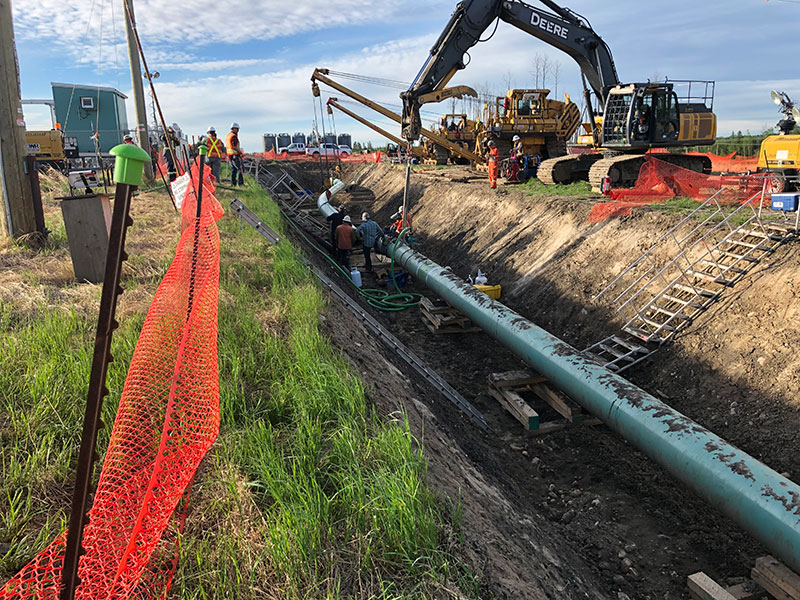Canadian Crude Exports from U.S. Gulf Coast Dip Slightly Despite TMX Startup
(Reuters) — About 150,000 barrels per day (bpd) of Canadian crude were exported from the U.S. Gulf Coast in June, slightly lower than average, despite the expansion of the Trans Mountain pipeline (TMX), which pulled some barrels west to Vancouver, shipping tracking data showed.
The $24.84 billion (C$34 billion) expansion started operations in May, adding 590,000 bpd of capacity for crude deliveries to Canada's Pacific Coast, where it can be loaded onto tankers, giving Canadian producers more access to U.S. West Coast and Asian markets.
TMX has the potential to impact global oil flows and freight rates - if more oil from Canada's West Coast heads to Asia, it could cut shipments from the U.S. Gulf Coast to India, China and South Korea. TMX could also displace shipments of some Latin American grades to Asian countries, which would then have to hunt for a new market.
Two supertankers and two smaller vessels loaded Canada's Access Western Blend and Cold Lake crude grades from the U.S. Gulf Coast in June for delivery to refineries in India, China, Spain and Peru, data from ship tracking services Kpler and Vortexa showed.
The 150,000-bpd exported in June compared with monthly average volumes of about 170,000 bpd in the last 12 months, according to data from Vortexa.
The ease of loading very large crude carriers (VLCCs), which can carry up to 2 million barrels of oil, at the Gulf Coast has helped maintain high levels of Canadian exports from the U.S. Gulf Coast, said Vortexa analyst Rohit Rathod.
In comparison, Aframaxes that typically transport up to 800,000 barrels are limited to loading only about 550,000 barrels at Vancouver because of port draft restrictions.
Those vessels have to sail to California to transfer the crude to a VLCC before traveling to Asia, whereas U.S. Gulf Coast VLCC loadings often occur just off Galveston.
Reliance Industries, for example, shipped 2 million barrels of Canadian crude in May from Vancouver to its refinery in Jamnagar, India. The following month, the Indian refiner loaded a supertanker off the coast of Texas for August delivery to India.
Competitors
Westbound volumes of Canadian crude on the Trans Mountain system have already ramped up by more than 300,000 bpd since TMX deliveries began in late May, energy data provider Wood Mackenzie said.
However, pipeline monitoring showed that utilization on Enbridge's competing Mainline remained largely unchanged from pre-TMX levels through June and early July, buoyed by draining storage inventories in Western Canada, Wood Mackenzie analyst Dylan White said. The Mainline pipe moves crude from Canada's Alberta to the U.S. Midwest.
July has already seen two loadings of 500,000 barrels of Cold Lake Blend from the U.S. Gulf Coast, according to Kpler's ship tracking data. However, weak Chinese demand may hinder those flows, analysts noted.
"We expect a decrease in Canadian flows to Midwest and Gulf Coast will materialize in the months to come as TMX continues to ramp up and the inventory cushion in Western Canada is depleted," White noted.
Related News
Related News

- Kinder Morgan Proposes 290-Mile Gas Pipeline Expansion Spanning Three States
- Enbridge Plans 86-Mile Pipeline Expansion, Bringing 850 Workers to Northern B.C.
- Intensity, Rainbow Energy to Build 344-Mile Gas Pipeline Across North Dakota
- U.S. Moves to Block Enterprise Products’ Exports to China Over Security Risk
- Court Ruling Allows MVP’s $500 Million Southgate Pipeline Extension to Proceed
- U.S. Pipeline Expansion to Add 99 Bcf/d, Mostly for LNG Export, Report Finds
- A Systematic Approach To Ensuring Pipeline Integrity
- 275-Mile Texas-to-Oklahoma Gas Pipeline Enters Open Season
- LNG Canada Start-Up Fails to Lift Gas Prices Amid Supply Glut
- TC Energy’s North Baja Pipeline Expansion Brings Mexico Closer to LNG Exports





Comments